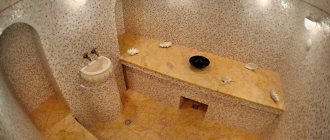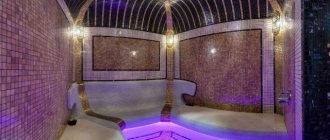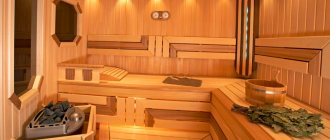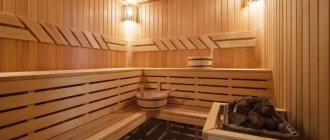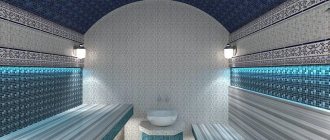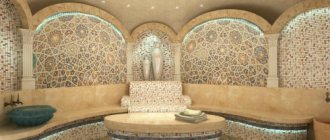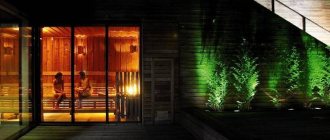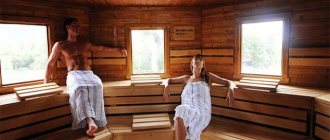Hamams
- All articles
- Saunas
- Spa areas
- Salt rooms
- Baths
- Snow rooms
- Shower of impressions
- Laconiums
The Turkish bath hammam is the same symbol of Turkey as the sauna is a symbol of Finland. In this article we will look at the hammam from a historical, architectural and cultural point of view.
Origin
The history of the hamam began long before the formation of the Ottoman Empire. The Turks who conquered Byzantium already had bath traditions. Turkish traditions merged with local Roman and Byzantine ones. Added to all this was the Muslim concern for cleanliness. This is how the Turkish bath appeared.
According to the European classification, a hammam is a steam bath, but with its own characteristics. The traditional hammam did not have one hundred percent humidity, as in its modern counterparts. Wood heating cannot create as much steam as modern steam generators.
The Turkish word hamam comes from the Arabic word hammam, which means something that heats. The hammam combines structural elements of Roman, Byzantine and Arab baths, but is distinguished by improved functionality and unique style.
Initially, hamams in Ottoman culture arose as extensions to mosques, but quickly gained independence. One of the best examples of a historical hamam is Cemberlitas Hamamı, built by the architect Sinan in 1584.
History of the Turkish Hammam
The history of the Turkish bath-hamam goes back to ancient times. During the existence of the Byzantine Empire, the famous Roman physician Galen worked in the town of Pergamum (now located in Turkey). He was a great connoisseur of thermal baths - the predecessors of the hammam.
The Arabs of the Arabian Peninsula eventually adopted some traditions from the Byzantines. Long before the advent of Islam, the eastern peoples were accustomed to frequent washing. This was due to the hot climate conditions. But if before the Arab conquest of the Levant they washed only with cold douches, after that procedures were added, but in a Turkish bath, using hot steam.
With the advent of Islam, oriental and Turkish steam baths became very popular, because the Prophet Muhammad himself highly appreciated their benefits. Over time, Turkish baths have been slightly modernized, but their essence remains the same.
Hamam structure
A typical hammam consists of three interconnected main rooms, similar to their Roman counterparts:
- Sogukluk (Roman vestarium), also called kamekan or soyunmalik, serves as a locker room and rest room. There you can leave your clothes, relax after the steam room, drink a refreshing drink or sleep.
- A warm room or a clique (Roman tepidarium) is an intermediate room between the cold and hot parts of the bathhouse. Here visitors adapt to the heat.
- Sichaklik, hararet (Roman caldarium) - a hot room in which steaming occurs.
An indispensable part of Sichaklik is a large dome. The dome has small windows creating half-light. In the center there is a large marble stone - chebek or gobek tasi (hot stone). On the sides of the chebek there are niches and fountains. Cichaklik is intended for steaming and massage procedures.
From Sichaklik you can get to Khalvety. These are small rooms with even higher temperatures. They are intended for those who prefer privacy.
Turkish hammam: beneficial properties and contraindications for visiting
Turkish hammam: beneficial properties
The Turkish hammam is a unique place that, if all the rules are followed, will help to significantly improve the condition of the body. According to people who regularly visit such a steam room, with its help you can get rid of many chronic diseases.
This is due to the fact that high temperature and humid air open the pores of the skin as much as possible, due to which the body more intensively begins to get rid of waste and toxins that are in the body of every person. In view of this, if you often visit the hammam, you can completely get rid of substances that poison the human body and, as a result, all organs and systems will begin to work correctly.
Useful properties of the steam room:
- It has a beneficial effect on the nervous system and, as a result, a person becomes calmer, more restrained and balanced. In addition, Turkish hammam helps to get rid of insomnia.
- Normalizes the functioning of the sebaceous glands , due to which a person’s skin problems completely disappear. And even if a rash appears, it goes away as quickly as possible, without leaving behind long lasting red spots.
- Normalizes the circulatory and vascular systems , as a result of which the work of the heart is normalized, blood pressure returns to normal and blood stagnation in the pelvis and abdominal region is completely removed.
- Warm and humid air removes lactic acid from the muscle mass , which provokes discomfort after prolonged or strength exercise. In view of this, if you have a similar problem, then try to at least sometimes go to the hammam steam room after visiting the gym.
- Humid air also has a beneficial effect on the respiratory system . Especially if the thermal effect on the body is combined with aromatherapy. Such a pastime will help get rid of bronchitis, tracheitis and contribute to a quick recovery after suffering from pneumonia.
Contraindications to visiting the steam room:
- Bronchial asthma
- Weeping or rotting wounds
- Various types of fungal diseases
- Hypertension
- Tuberculosis
- Nervous and mental disorders
- Cardiovascular diseases in the acute stage
Types of hammams
There are several types of hammams, differing in function and architecture.
The separate hammam was designed and built with separate operating hours for men and women.
The double hammam has separate entrances and sections for men and women.
Hamams are also built on natural springs. This hammam will have spring water, and in the middle of the sichaklik there will be a thermal pool.
Marble for hamam
Marble is used for cladding walls, floors, seats and making chebek. Marmara and Kemalpasha varieties of marble are best suited for hammam. Marmara marble is mined on the island of the same name, famous for its deposits of this valuable stone. The sea surrounding the island is also called the Sea of Marmara.
Kemalpasa is one of the best white Turkish marbles, the deposits of which are located in Bursa.
As we can see, traditional types of marble for hamam are light. Obviously, the first hammam builders came to this on their own, and modern masters have a scientific basis for this. The steam in the hammam condenses into distilled water. Such water will actively react with marble. As a result, stains will remain on the marble. On dark types of marble these stains will be especially noticeable. In modern hammams, in which steam is produced by steam generators, there is much more steam than in the ancient ones. Therefore, it is better to replace marble in them with tiles or other building materials.
Essential oils for Turkish bath hammam: list with names and descriptions of properties
Essential oils
Everyone has heard about the benefits of natural essential oils. And if you combine them with warm steam, the effect will be very good. As a rule, essential oils are used in a steam room in two ways.
They are used directly for rejuvenating and healing procedures by applying to the skin, or they are filled with the healing aroma of steam. A modern Turkish hammam requires the presence of a special steam generator, which saturates the steam in the room with a pleasant aroma at a certain time interval.
List of essential oils that can be used in a steam room:
- Lavender. It has antibacterial and soothing properties and helps relieve vasospasm. It is usually recommended for use by people who have been in a stressful situation for a long time.
- Menthol. Has a beneficial effect on the respiratory system, heart and blood vessels. It has pronounced analgesic properties. With its help, you can get rid of migraines and completely eliminate the nausea that almost always accompanies this problem.
- Cedar. A powerful immune system stimulant. In addition, this oil works well against skin problems such as psoriasis and eczema. Thanks to its healing and anti-inflammatory properties, you can minimize the occurrence of these diseases.
- Fir. This essential oil is most often used to treat colds, sore throats and bronchitis. It has pronounced expectorant and antiseptic properties.
- Tangerine and orange. They help relax the muscles of the body, tone the skin and fight insomnia very well. In addition, they can be used for anti-cellulite massage, as well as procedures for skin rejuvenation.
- Bergamot. This oil will help you cheer up after a hard day at work, and will also tone your skin. Bergamot is considered a natural aphrodisiac, so it can be used to solve intimate problems.
Traditional accessories for hamam
To visit the hamam, a Turkish bather could take with her up to 20 different items. She wrapped them in a bohca bundle. Among them were:
- A peshtemal is a large towel with fringes at both ends to wrap around.
- Nalin - special wooden shoes that will prevent you from slipping on a wet floor. They were often decorated with silver and mother-of-pearl.
- Tas is a copper bowl for pouring water over the body. The bowl was covered with fluted patterns and inlays made of silver, tinned copper or brass.
- Among the soap accessories was a kese - a rough mitten. It cleanses pores of dirt and is used for a stimulating massage. Kese is woven from hair or plants.
- In addition, the scarf could contain: jewelry boxes, gilded soap dishes, mirrors, henna bowls, perfume bottles, boxes of tea and coffee.
Hammam ventilation: technology, features and diagram
There is high air humidity in the hammam, which means that natural ventilation is not enough, forced ventilation is necessary.
Ventilation in the hammam is planned at the design stage. To organize air exchange, make two holes in the foundation, located on opposite sides, as well as two holes in the floor.
The floor has small gaps that provide natural air exchange.
The following ventilation schemes in the hammam are common:
- The first scheme provides two openings located on opposite walls at different heights: the supply opening is lower and the exhaust opening is higher. In this case, the air comes from below and more intensely. This scheme is considered the most effective.
- The second scheme is the opposite of the first: the holes are also on opposite sides, with the supply opening higher than the exhaust one. With this option, the air flows less intensely, but the heat is better retained in the hammam.
- The third scheme involves the location of two holes on one side. It is considered less effective and is used only if it is impossible to implement other schemes.
Proper ventilation in a hammam is the key to its effectiveness! The healing effect of visiting the hammam will only be if clean air enters the room; stagnant air is not beneficial.
We recommend reading:
Do-it-yourself bathhouse from scrap materials
Hamam in Turkish culture
Hamams played an important role in the public life of the Ottoman Empire. It was much more than just a place to cleanse the body. People of any rank and status could come to the hammam: young, old, rich, poor, city dwellers or rural residents. Here they communicated, conducted business negotiations, had fun, relaxed, and performed traditional rituals and ceremonies. Hamams were numerous and existed in almost every Turkish city


